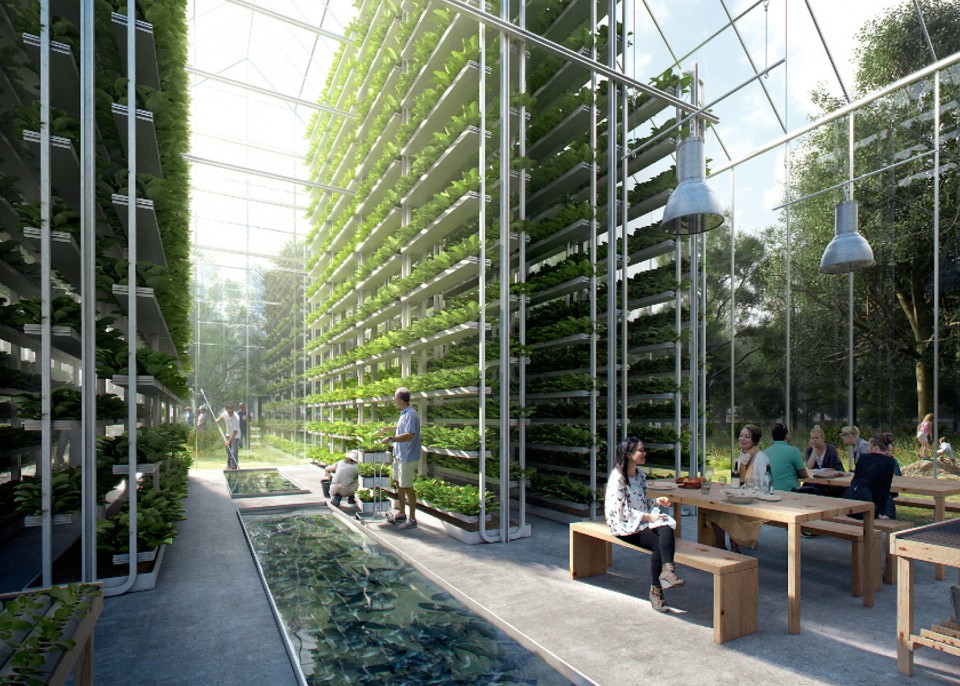Vertical Farming, continued
This is page 7 of our nine page series on hydroponic vertical farming. Click any of the below pages to jump to that page.
Page 1 Page 2 Page 3 Page 4 Page 5 Page 6 Page 7 Page 8 Page 9

This public place features vertical farming towers growing food next to dining areas where that food is enjoyed. Public places like this are another variation on the theme of bringing high-density agriculture not only into cities, but into urban populations which have lost most of their other connections to how and where their food is grown. Photo courtesy of the an urban farming article at 99percentinvisible.org.
Estimated Cost
Vertical farming is more sensitive than most other forms of hydroponics, to the careful balance between high-value crops under intensive production, and higher-than-usual infrastructure costs. For the hobbyist with a single rack of salad greens growing vertically against a sunny wall, that hobbyist won’t have too many costs beyond what he or she would have had with those trays laid out one next to each other rather than stacked. If the stack is 6’ high, a grower would need a stepladder to reach that highest growing tray, and a stout rack to hold it securely. Commonly available pumps will be sufficient to drive the nutrient solution to the uppermost plants, and lighting from the top and/or side would be helpful but not required.
The real costs kick in as we scale up in size, particularly in height. If that same grower wanted to extend that single rack to, say, 20’ tall, suddenly all that math changes. The same plants, using the same growing system (say, NFT), will need much more robust pumps to drive irrigation solution high enough to reach the highest trays. The rack itself will need to be industrial-strength not only to hold all that extra weight, but also to ensure it doesn’t wobble or tip over. Plant manipulation would be much more complicated because the grower would need a scissors-lift, a catwalk or scaffolding system, a stout rolling ladder, or some other way to reach those highest plants. And lighting would become an issue, to ensure that sufficient light was available to all the plants in all the trays.
A quantitative assessment of “how much would be too expensive” is of course impossible without knowing more details about any given situation. However, a qualitative analysis is relatively easy: the moment the uppermost tray is out of reach, everything gets a LOT more expensive. More expensive in terms of time, money and energy. The crops grown would need to be very high value, and the market demand very strong, to make that investment worthwhile. Even if the hobbyist was an accomplished DIYer with above-average mechanical aptitude, and opted for one of the revolving tray systems, the extra costs involved would still require a high-dollar crop and strong market demand. Or, the grower would have to acknowledge that he/she was using the system simply for the “coolness factor” rather that because it was profitable.
Do It Yourself Potential
Small-scale vertical farming projects are very much within the realm of the DIY’er. Any grower who has a lot of interest in this approach, and is willing to experiment with different variations within this approach, will be able to build small scale growing systems which can be profitable if so desired. The smaller the system the easier that task will be.
NFT channels or buckets mounted on a rack are the two most popular ways for DIY’ers to start with vertical farming systems. A few NFT channels mounted on a rack, or a line of buckets on shelves along a wall, can definitely produce a lot of vegetables if the lighting, irrigation and handling issues are worked out. Flood and drain systems can certainly be used, but they are often so heavy that any rack system would be much more robust than a DIY wants to build. On the other hand, many DIY’ers are adept at finding unique solutions to any given challenge, and/or they have access to unique equipment and environments. For instance, if a DIY’er has access to an old warehouse with existing industrial-strength racks, then weight may not be much of an issue. Bottom line, a dedicated DIY’er can definitely make use of whatever materials he/she has access to, and build a vertical farming system based on that unique combination.
As we scale up, all the different facets get more complicated. The first and foremost issue is, as we’ve already discussed, the height of the trays. Setting up sturdy enough racks, developing efficient ways to reach them for all the various tasks, will become challenges which can quickly become too complex for the average DIYer. Experimentation here can yield some constructive, cost effective results, to be sure, but the DIY must be willing to really carefully crunch numbers in advance. He/she must also carefully track costs (both in terms of actual money outlay, AND in terms of labor) to determine if the crop(s) is/are worth all that extra hassle, and if the production truly offsets the costs.
BACK NEXT
This is page 7 of our nine page series on hydroponic vertical farming. Click any of the below pages to jump to that page.
Page 1 Page 2 Page 3 Page 4 Page 5 Page 6 Page 7 Page 8 Page 9